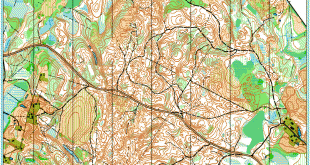Is it OK to fork men against women in a Mixed Sprint Relay? At the Norwegian Championships sprint this weekend the answer was obviously yes. The first leg for both men and women with the four forking controls are shown above.
To make it extra tricky from a fairness point of view the forking controls are in the forest where it is difficult to make exact measurements on the length of the different variant.
Any opinions on this one?
[Update: Note that the routes drawn on the map above are not necessarily the best. As split times were not available at the time of writing, unfortunately no detailed analysis could be made]
2015 NM sprinstafett etp 1

» See map in omaps.worldofo.com
 World of O News
World of O News






Good point. Generally, there were not many forked controls on this event.
@Agnar: That’s another issue. The women’s course wasn’t really interesting from a forking point of view. The men’s was better (but I heard there were some other controversies there?)
This forking setup was quite simply broken!
You have to fork ladies against ladies, men against men unless all the alternatives have been tested to be effectively the same time/length, for both sexes.
BTW, both men and women tended to take another route towards controls C & D, cutting the side of the start triangle and down past control 20.
Thanks for your opinion. I agree with – and I’d add that I can’t see that you can test effectively enough to fork men against women.
I agree. I was very surprised when I learned the first control had been forked with the men. I don’t think that’s right in a national championship event.
IOF sprint relay guidelines require separate forking for each sex, and that is the only way to guarantee a fair competition.
As Terje says, the right route choice is probably better for the rightmost controls. Øystein Kvål Østerbø estimated he lost 10 sec by going straight to D.
Thanks, Ståle. Good point with the IOF sprint relay guidelines (which of course the controller in the national championships should take a look at).
“that is the only way to guarantee a fair competition” – I totally agree with Ståle, forking between men and women is unfair.
I would argue that such a minimal and unbalanced way of forking is unfair anyway. Looking at the replay, you can see that all runners passing through D are at least ten seconds down and from there on, it is simply following the pack.
Concerning the question about the difference between man and women, I tend to agree with the IOF rules. It is the most fair to have different forking for women and for men. In some situations, it is however not so easy to achieve this since the forking is also a way to spread the pack at the start location. When organising a mixed relay in small streets, things tend to get crowdy at the first controls and spreading the pack over four controls rather then two might provide a good option.
I think forking with different expected time for an optimal execution of the best route-choice in general is a problem with relays. Many top athletes tend to agree to this, refer e.g., a recent interview with TG. For men at the WOC & EOC relay championships we have seen many examples that it is a significant and medal-determining advantage to have the longer forking early in the relay and the shortest forking at the last leg, e.g, WOC relay 2010 and EOC relay 2014. Since there is a pack of runners more or less together it is easy to run on backs and compensate for a longer forking on the first leg. On the third leg the short forking can be used to get a key and decisive gap. Much more effort must be put into making the forking equal in time. As long as all forkings have very similar “time length” you can fork women against men without any issues. For me, the Tønsberg first control forkings are equal enough to be acceptable, the main reason runners lost time on the C and D forkings are not going right from the start triangle, and bad execution (hesitation and bad direction) in and out of the control.
I can see two issues with combined forking for men and women.
1. [the easy one – at least with current running speeds] the men run faster than the women so such forking would be bad for uneven forkings (although uneven forkings give issues even with single-sex as mentioned above)
2. Some types of terrain seem to slow men down less than the women. I’ve seen a few WorldofO anaylses where it is straight vs round and for the men straight was better, but round seemed better for the women. Of course this isn’t the type of terrain that would (should?) be used in a mixed [sprint] relay IMO, but might just be worth a few seconds when you are off tarmac – and indeed the first splitting above might have been an example.
If you have one leg that’s 10sec longer (which is pretty poor on a sprint), then the unfairness in forking men against women is still only about 2sec. There are plenty of other bigger unfairnesses than that.
My point of view is that you should avoid all potential unfairnesses that you can. 2 seconds can often be enough to decide a relay – would you like to decide the gold medal due to something you can avoid very easily?
Wise words!
Always risky to disagree with the blog owner, but I’ll do it anyway. Forking men against women will give a second or maybe two “known unfairness”, however, it will make it much easier to break up packs and prevent following which probably leads to a (much) larger, but unknown (or at least un quantified) unfairness.
The discussion here in many ways seems similar to the one we had when Micr-O was tried as a forking system for relays and individual races. It seems like most orienteers agree with the comments in this thread. An unfairness you can clearly quantify is perceived as bad, even if it solves a much bigger problem.
Different opinions is a good thing; if only people agreeing with the author would write their comments, that would not bring the world forward. So thanks a lot for your comment.
If you have a very good course setter/controller, you can get away with forking men against women. The problem is that if you open up for it, you will have situations were you can get very bad results.
For the mixed sprint relay it might actually be an even bigger issue if the time difference for the longest and the shortest forking on a leg is large (e.g. 20-30 seconds which we have seen some times), as the ones with long forking in the start of the relay can use that to their advantage in the end of the relay.
My point, however, is that you should work as hard as you can on fairness issues in all steps to ensure the best possible result. If you allow some “small unfairnesses” here and there, it can add up to a lot in the end – especially if the organizer/course setter/controller is not 110% competent ….
That’s a bit of a cheap shot Jan – obviously I’m not proposing unfairness just for the sake of it.
Forking is unfair and so is following, but we happen to know how unfair forking is. Forking men vs women would be fairer if people are unfairly gaining more than 2 sec by following/chasing. Do you think so?
The ideal is for everyone to run t an invisibility cloak (which could still be seen by IOF on TV, of course). Until we can do that, we’re stuck with forking.
Sure, the advantage of seeing other runners ahead leads to bigger time differences than the difference due to forking men vs women, but as long as you can make good courses without forking men vs women, I can not see a good reason to do it? In this example there are many other better ways to fork than done here, the rest of the course for the women is unforked except for a minute difference for a control in the middle of the course. Why not have two forkings at the first control and rather introduce better forking at other controls? It looks like the course setter put all energy into this first control…
I agree they could have done the forking differently. But the problem here is that the forkings are unbalanced, not that they fork men vs women. The problems you mention would still be there even if the course was designed for teams of all men.